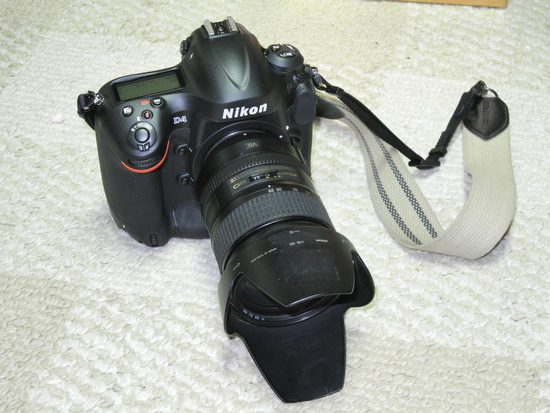 |
| Nikon D4 with Nikkor 28-300mm |
Importance of Simplicity
It is very common when I am out taking photos as a professional that people will often hand me their camera and ask me to take a photo of them with their friends. They see my gear hanging around my neck and shoulders and figure, he knows what to do.
Camera manufacturers have not gone the way of Steve Jobs when it comes to camera design. Frankly, I think most every camera is quite difficult to use. Even these point and shoot cameras that people hand to me and want me to take a photo of them with their friends are complex.
One of the first things I often and wishing I can do to improve those photos for folks is to turn on their flash outside. This will help get rid of those awful shadows in their eyes making them look like racoons.
Just try and pick up four or five different cameras and quickly turn on the flash. It is quite difficult.
Ideally when I make a switch to a new camera system I would like to just trade all my cameras at once and then buy the latest gear. This is how I did it in the days of the film cameras.
However, today these professional cameras are not $1,000 for the top of the line cameras. Just one Nikon D4 costs $6,000 or what I would have spent to replace all five of my film cameras.
With film I carried five cameras. I had two black and white cameras and two color cameras. I had slower daylight film for outside and high speed tungsten indoor film in the other cameras. I also had a backup camera.
The good news today is I do not need five cameras. I need two or three cameras. Today, most pros carry two cameras for one major purpose–backup. You cannot afford to be on a job and the camera stop working and not have another camera to finish the job.
The other reason most pros also like a second camera is to avoid switching lenses on bodies too often. Each time you switch a lens you run the chance of dust getting on the sensor. The other problem is the time it takes to switch lenses can be the difference of getting or missing a shot.
Different cameras can cost you a shot. The difference in the Nikon D3s and the Nikon D4 is not so great that in a hurry you know which one is in your hand. However, the minute you decide to change how you are focusing you will realize you have the other camera in your hand when you try and change it.
Since I have been shooting digitally, I am usually having to buy a new camera at a time and sell some old gear. It just is difficult to order two $6,000 cameras for a total of $12,000.
Every time I make the switch to a new camera till I have all identical cameras I find myself getting very frustrated. It isn’t that the new camera isn’t better designed, it is the problem that the improvements made changes.
It would be easier to have four cameras. Two studio and then two DSLR journalistic cameras. This way when you are shooting high resolution stock images of products you had your primary camera and backup all the same. Same for the journalistic camera that helps you do video in the field and shoot at high ISO.
Financial Revelation
Back in the days of film, my gear was easily 1/4 to 1/3 the cost of what I need today.
When I shot film I didn’t need a computer, PhotoShop or Lightroom and all the gear to insure color accuracy of the monitors.
A professional photographer today will most likely have two pro cameras costing $3,000 to $25,000 each and a computer digital workstation (Computer, Photo Software and calibration devices) which run from $5,000 to $15,000.
So when you are shocked at why their prices are higher today when there is no film you know it is due to the cost of digital.
In the days of film photographers could keep their cameras for easily five years. Today, you can keep your camera that long, but your competition will have gotten the latest digital camera that let’s them make photos you cannot on your present camera. You keep up to stay competitive, which now costs more than ever.
How to keep it simple?
Buy all the same type of cameras and stay with the same manufacturer of camera so the learning curve is shorter. While the cameras are quite complex the key to simplicity is not to introduce different cameras.
I shoot now with two Nikon D4 cameras. I want to keep it simple. I also carry my Nikon P7000 with me all the time. I like to keep my eye fresh so when I am on the job I am thinking about the shot. It would be just like a musician who practices every day so that when they perform they are at their best.

